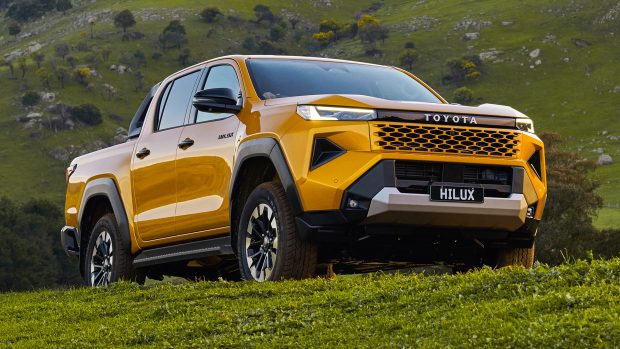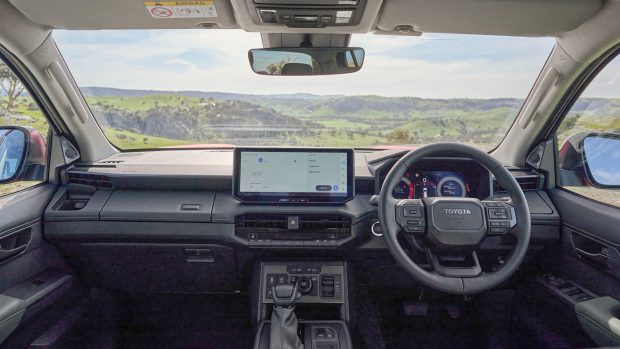-
Car Reviews
- All reviews
- Midsize SUVs
- Small cars
- Utes
- Small SUVs
- Large SUVs
- Large cars
- Sports SUVs
- Sports cars
- Vans
Latest reviews
- Car News
-
Car Comparisons
Latest comparisons
- Chasing Deals
It might share its chassis and engine with the old Hilux, but the ninth-generation focuses on what its buyers actually want, or so says Toyota
Toyota has finally unveiled what it’s calling the “most Australian Hilux ever developed”, which is set to go on sale in Aussie showrooms in a matter of weeks.
While the US-market midsize pickup, in the Tacoma, switched to the same GA-F platform as the Prado back in 2022, the ninth-generation Hilux will carry on with the same IMV platform, which underpinned the previous model.
A fully electric version has been confirmed for 2026, with a hydrogen fuel cell (FCEV) version set to follow in 2028. No hybrid or plug-in hybrid is planned at present, but haven’t been ruled out either.
As expected, the core cab area remains largely unchanged, and the 2.8-litre ‘1GD’ turbo-diesel four-cylinder engine carries over with outputs of 150kW/500Nm when paired with a six-speed automatic transmission. For manual variants, torque is capped at 420Nm.
Dual-cab SR5 grades and above will be fitted with a 48-volt mild-hybrid system, adding 8.5kW/65Nm to the drivetrain at low speeds, as per the current model.
A total of 16 different diesel variants in single-, extra- and dual-cab configurations will be available, mated to both 4×2 and 4×4 drivetrains, with the latter remaining a part-time 4×4 system.
At launch, the lineup will consist of the Workmate, SR, SR5, Rogue and the returning Rugged X grade but will likely grow with time.
Pricing for the new Hilux will be released here at chasingcars.com.au this Wednesday at 2pm.
Utilising a classic coil-sprung front end mated to a leaf rear, Toyota has retuned the suspension with a heavy-duty setup on Workmate and SR, while SR5 grades focus more on ride comfort.
Thicker front suspension towers have been fitted to accommodate the new electric power steering system, and the front cross members have also been tweaked, along with other structural changes made to improve crash safety.
Along with a standard locking rear differential, the Hilux will feature Multi-Terrain Select traction control modes, as seen on the Prado 250 Series, on automatic SR 4×4 grades and up. SR5 grades also net a 360-degree camera system designed to help navigate off-road terrain.
The interior has been overhauled in the Hilux with a greater focus on technology but Toyota stresses this has not been done at the expense of usability.
A 7.0-inch digital instrument cluster is standard on Workmate and SR grades, with a 12.3-inch unit fitted on SR5 grades and above.
Sitting adjacent all on variants is a 12.3-inch touchscreen tasked with multimedia, fitted above a series of physical buttons with old-school twisty dials for single-zone climate control fitted to the Workmate, while higher grades feature chunky switches and dials with an overall dash design and shifter reminiscent of the 250 Series Prado.
While the midsection of the ninth-generation Hilux may look nearly identical from the outside, Toyota’s Aussie designers in Altona, Victoria, have radically redesigned the front and rear in a style they’ve called Cyber Sumo.
Aggressive front headlights and a one-piece grille and front fascia are said to convey strength and dependability, with a tailgate step featured on some grades and the classic ‘Toyota’ name etched into the tailgate at the rear.
It’s going to be a big week of Toyota content here at Chasing Cars. Stay tuned for pricing and our full review of this model in the coming days.
Latest news
About Chasing cars
Chasing Cars reviews are 100% independent.
Because we are powered by Budget Direct Insurance, we don’t receive advertising or sales revenue from car manufacturers.
We’re truly independent – giving you Australia’s best car reviews.




